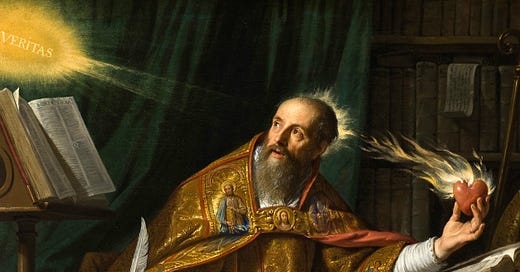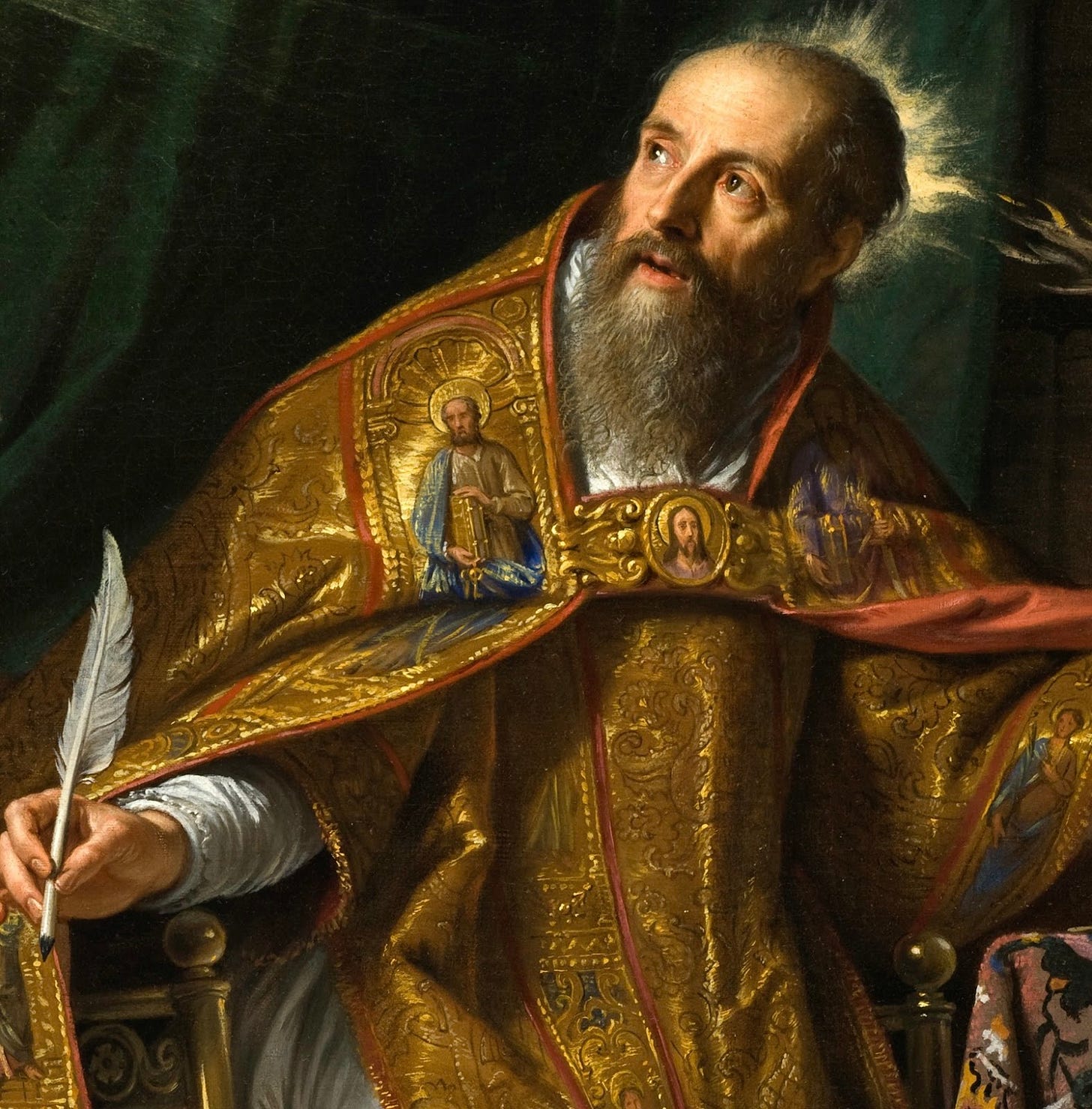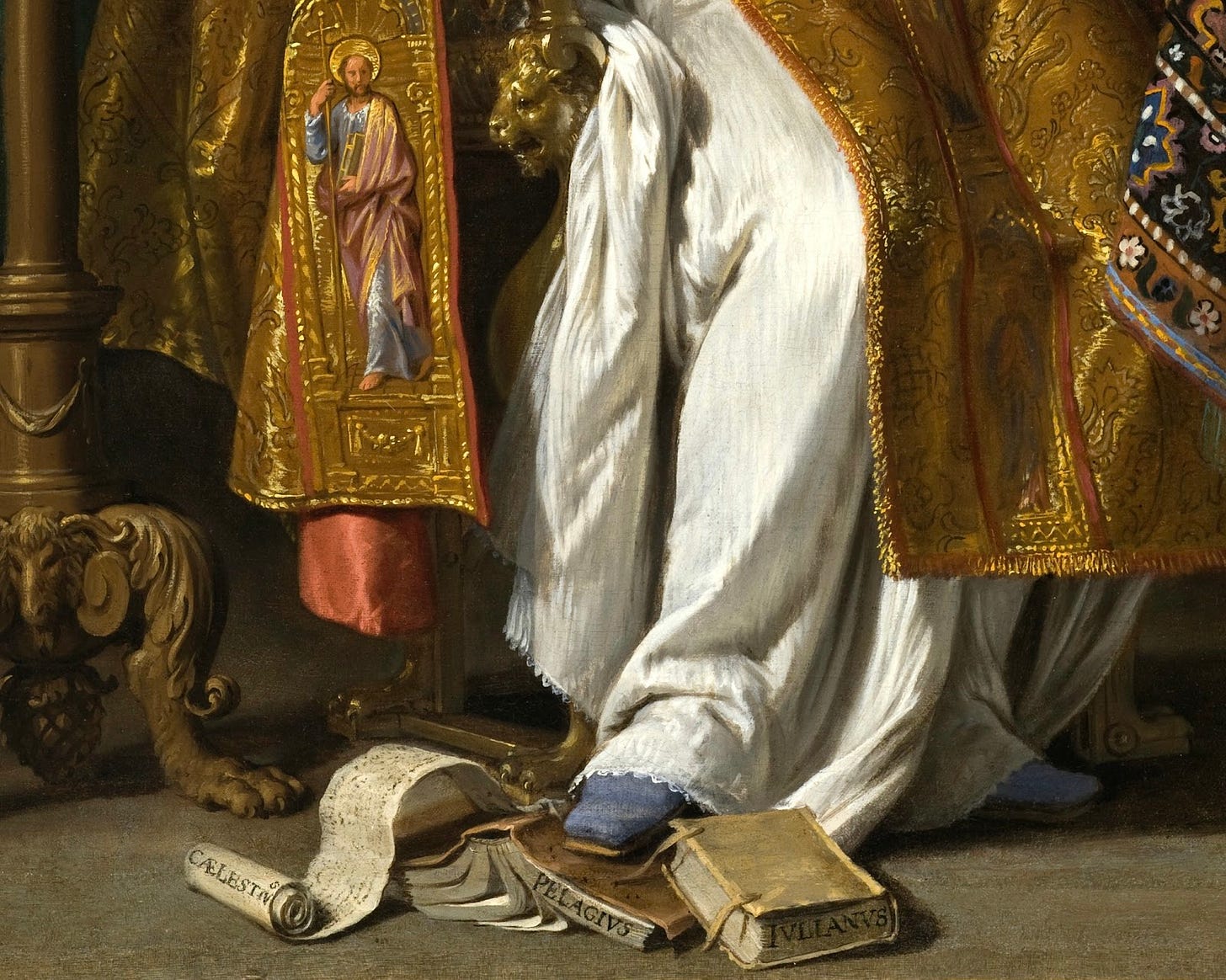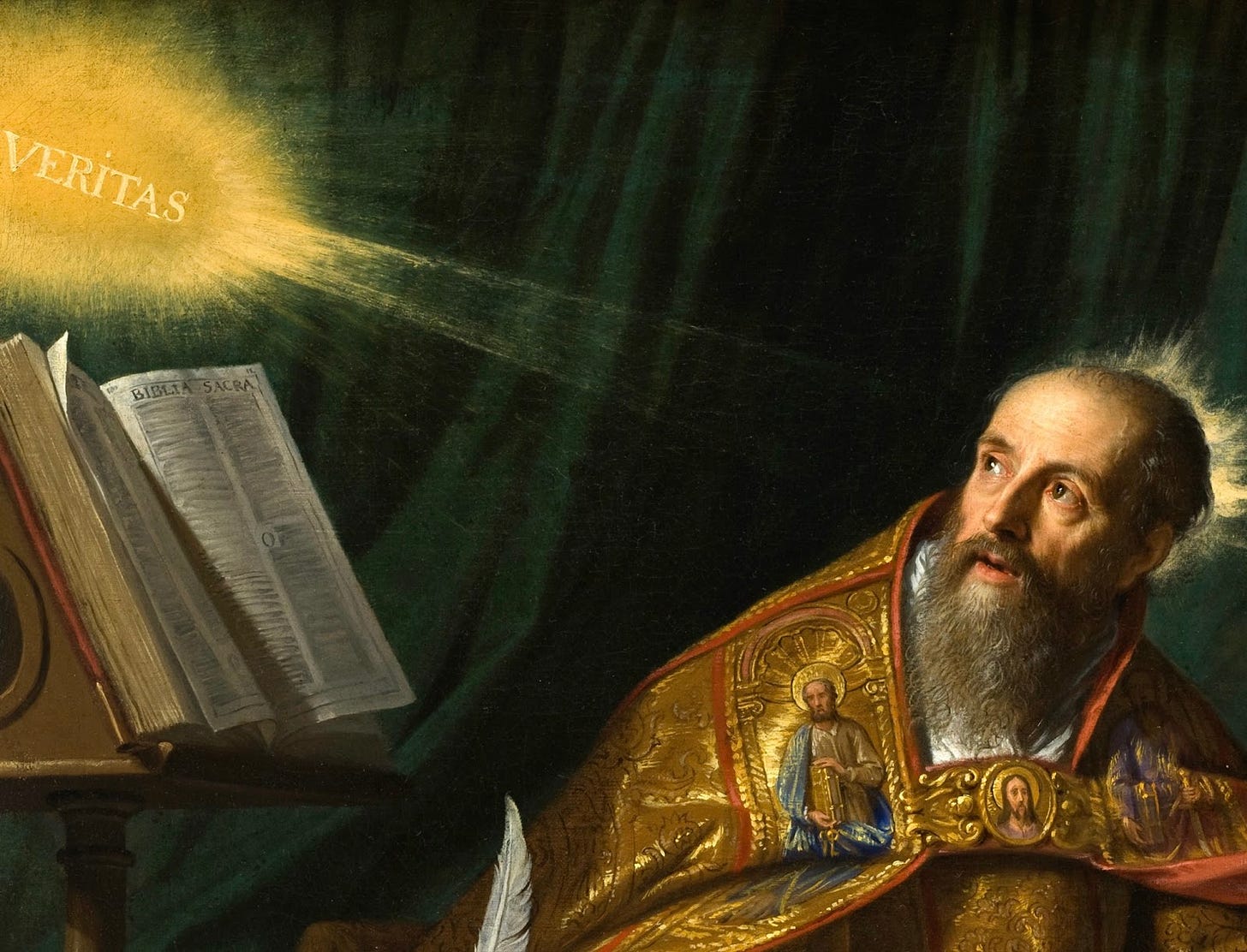
If you visited the L.A. County Museum of Art today, you would not see this famous painting of Augustine due to the fact it is not currently on display. Chances are you have seen it before, though online—perhaps you saw it perusing social media or reading an article on Augustine.
This painting has become the iconic image of the Bishop of Hippo. It is no wonder why. The colors are iridescent. Even small details have a splendor to them. In this portrait, Philippe de Champaigne manages to movingly capture both Augustine’s sensitive heart and his penetrating intellect.
Originally a Flemish painter, Champaigne helped to found the art school in France that prized itself on engaging art with ideas from classical texts1. So, it’s fair to assume that he engaged with Augustine’s writings while painting this portrait. Eventually, Champaigne drifted away from this school as he became more religious. Still, this painting combines the best of his more colorful paintings of the French royalty and his more religiously inspired but austere portraits.
The painting itself is a visual synthesis of many of Augustine’s writings in which love, wisdom, and divine illumination are intimately connected. Champaigne painted the saint’s burning heart and mind flaring towards each other which I think illustrates what John Burnaby wrote about Augustine's synthesis:
Love does not of itself lead to knowledge, nor knowledge of itself to love. God must give His presence to the soul, both as the light that enlightens and as the fire that kindles; and knowledge and love must grow up together, mutually confirming one another (Amor Dei. London: Hodder & Stoughton, 1938, 143).
While Gothic artists perfected the altarpiece and the art of heaven, the best Baroque artists mastered the art of conversion. This portrait is an example par excellence of this Baroque specialty.
Although Champaigne paints Augustine as an older man in his episcopal garments, he includes numerous allusions to Augustine’s first turn to Christ. The most obvious reference is the way Augustine dramatically turns as he looks to see the light of Christ above his Bible. The light of truth shines from the upper corner of the painting and penetrates his mind as well as his heart, which he holds in ecstasy, outside of himself.
Augustine’s flaming heart brings to mind the famous line from The Confessions: “For Thou hast made us for Thyself and our hearts are restless till they rest in Thee” (Confessions 1:1). 2
Here, Champaigne puts Augustine’s restless heart in conversation with his pursuit of Wisdom. Later in his autobiography, Augustine recounts how as a young orator his conversion from youthful ambition to wisdom began with Cicero.
How did I then burn, my God, how did I burn to wing upwards from earthly delights to You…For with You is wisdom. Now love of wisdom is what is meant by the Greek word "philosophy,"and it was to philosophy that that book set me so ardently (Confessions 3.4.8).
Eventually, after following some of the popular philosophies of the day and also falling into the lure of sexual sins, this thirst for wisdom finally led Augustine to Christ, or rather Christ found Augustine. It’s no coincidence that Christian artists at the time preferred to depict Christ as the True Teacher and as Wisdom.

Augustine recounts his conversion in the Confessions, the spirit of which Champaigne captures in this painting.
And suddenly I heard a voice from some nearby house, a boy's voice or a girl's voice, I do not know: but it was a sort of sing-song, repeated again and again, "Take and read, take and read”
I snatched it up, opened it and in silence read the passage upon which my eyes first fell: “Not in rioting and drunkenness, not in chambering and impurities, not in contention and envy, but put ye on the Lord Jesus Christ and make not provision for the flesh in its concupiscences.” (Romans 13:13)
I had no wish to read further, and no need. For in that instant, with the very ending of the sentence, it was as though a light of utter confidence shone in all my heart, and all the darkness of uncertainty vanished away. (8.12.29)
Champaigne deftly brings together the many parts of Augustine’s conversion here.
First, he paints Augustine wearing his Bishop’s cope with the face of Christ on the clasp, pointing to the reading from Romans—“put on the Lord Jesus Christ.” The episcopal garments also suggest the way Augustine put on Christ in his work as the Bishop of Hippo, a role he would rather not have taken up but did so out of obedience to the Church. For decades, he wearied himself, settling mundane disputes and shepherding his flock. The cope is also adorned with images of the apostles, perhaps a nod to Augustine's belief in apostolic succession.3
The Holy Spirit seems to move through the painting—in the fluttering pages of books and in Augustine’s garments which appear to flicker as if alight. Champagne paints the saint trampling the books of heretics. As Bishop of Hippo, Augustine wrote no less than 35 treatises against the Pelagian heretics—those who denied or downplayed our need for God’s grace. It is for these works that Augustine received the title “the Doctor of Grace.”
As in the scene from his Confessions, Augustine turns to look at Scripture, which is illuminated for him by the light of Christ. Augustine repeatedly returns to this idea of “Divine Illumination” throughout the Confessions and in later works such as De Magistro.4
One such passage reads:
So was my soul at that time, for I did not realize that it had to be illumined by another light, if it was to be a partaker of truth, because it is not itself the essence of truth. For Thou lightest my lamp, O Lord; O my God, enlighten my darkness; and of Thy fullness we all have received. For Thou art the true Light which enlighteneth every man that cometh into this world: because in Thee there is neither change nor shadow of alteration. Confessions 4.15.25)
Although scholars find it notoriously difficult to pin down what Augustine means by “divine illumination,” Edward Feser reasons it can be understood as the light by which God allows the intellect to sees eternal truths.5
St. Augustine connects the relationship between Wisdom, understanding of eternal things, and love as a crucial part of his understanding of the Trinity.
Yet unless we love him even now, we shall never see him. But who can love what he does not know?.. And what does knowing God mean but beholding him and firmly grasping him with the mind?….. But then to behold God and grasp God as he can be beheld and grasped is only permitted to the pure in heart - "Blessed are the pure in heart, because they shall see God (Matt.5:8)"... so before we are capable of doing this we must first love by faith, or it will be impossible for our hearts to be purified and become fit and worthy to see him. (The Trinity 8.6)
Finally, it’s fitting that Champaigne paints this saint surrounded by books. Peter Brown says that he wrote over a million words, but it’s clear from his life that Augustine also married his love of wisdom with his love for God and his neighbor.
At the end of his life, when he could no longer read small print, Augustine had the penitential psalms put around his room in large print. His first biographer Possidius says Augustine spent his last days “gazing at them and reading, and copiously and continually weeping as he read.” I’ve always thought it fitting that the scholar saint died surrounded by the Word of God, soon before he saw Wisdom, the true Word, face to face.
Think cold Neoclassical paintings by artists like Nicholas Poussin.
I’m using the Sheed translation. Although I have only read three translations, it is far and away the best. This is the translation most Catholics will recommend.
In the Catholic Church, there are many other things which most justly keep me in her bosom. The consent of peoples and nations keeps me in the Church; so does her authority, inaugurated by miracles, nourished by hope, enlarged by love, established by age. The succession of priests keeps me, beginning from the very seat of the Apostle Peter, to whom the Lord, after His resurrection, gave it in charge to feed His sheep (Jn 21:15-19), down to the present episcopate.
St. Augustine (354–430): Against the Epistle of Manichaeus called Fundamental, chapter 4: Proofs of the Catholic Faith
“You had pierced our hearts with the arrow of Your love, and our minds were pierced with the arrows of Your words. To burn away and utterly consume our slothfulness so that we might no more be sunk in its depths, we had the depths of our thought filled with the examples of Your servants whom You had changed from darkness to light and from death to life; and these inflamed us so powerfully that any false tongue of contradiction did not extinguish our flame but set us blazing more fiercely.” (Confessions 9.2.3)
“Late have I loved Thee, O Beauty so ancient and so new; late have I loved Theel For behold Thou wert within me, and I outside; and I sought Thee outside and in my unloveliness fell upon those lovely things that Thou hast made. Thou wert with me and I was not with Thee. I was kept from Thee by those things, yet had they not been in Thee, they would not have been at all. Thou didst call and cry to me and break open my deafness: and Thou didst send forth Thy beams and shine upon me and chase away my blindness: Thou didst breathe fragrance upon me, and I drew in my breath and do now pant for Thee: I tasted Thee, and now hunger and thirst for Thee: Thou didst touch me, and I have burned for Thy peace.” (Confessions 10.27.38)
“Similarly, light from the divine intellect is what illuminates the Forms for our intellects. This divine light is not itself what the intellect sees (contrary to the first, ontologistic interpretation of Augustine), but rather that by which the intellect sees. But still (and contrary to the second, Thomistic interpretation of Augustine), it is something distinct from any activity of the human intellect itself, and distinct from God’s conservation and concurrence with it. It is an extra divine assistance without which the intellect, relying merely on its own capacities, would be unable to grasp the necessity, eternity, and perfection of the Forms.”







Incredible article as always Amelia! The movement of the flames toward each other is a marvelous detail. It reminds me of the Holy Spirit at Pentecost in the tongues of flame. And it also reminds me of T. S. Eliot in the Four Quartets:
“The dove descending breaks the air
With flame of incandescent terror
Of which the tongues declare
The one discharge from sin and error.
The only hope, or else despair
Lies in the choice of pyre or pyre-
To be redeemed from fire by fire.
Who then devised the torment? Love.
Love is the unfamiliar Name
Behind the hands that wove
The intolerable shirt of flame
Which human power cannot remove.
We only live, only suspire
Consumed by either fire or fire.”
Truly truly, St. Augustine was aflame with the Holy Spirit, and that flame made him both fully alive and repentant of his own “sin and error.” He was redeemed from the fires of his passions by the flames of the Holy Spirit. A wonderful painting and very insightful analysis!
Excellent essay, I learned a great deal. May God bless your work Amelia, as you also are a seeker of, Veritas et Lux.